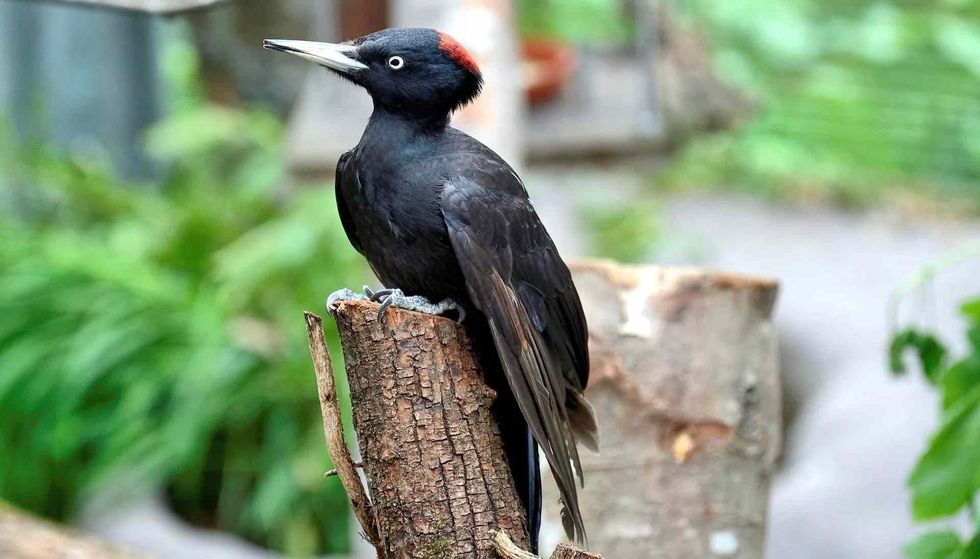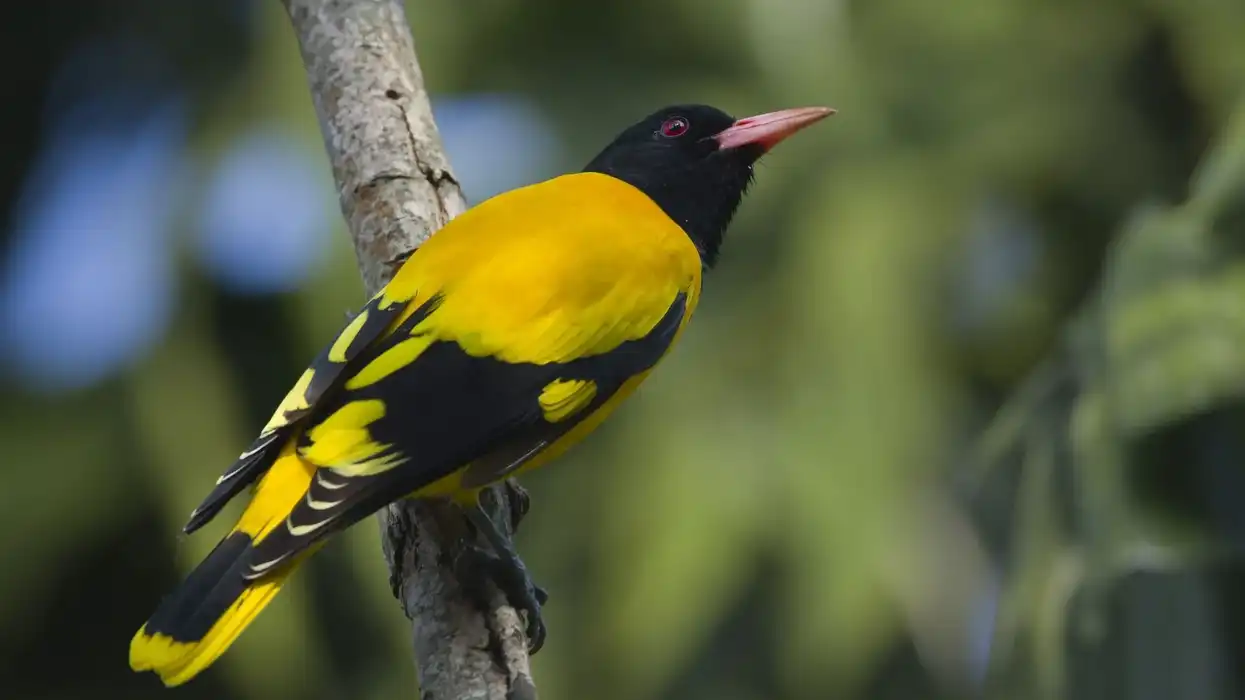The black woodpecker also known as the Dryocopus Martius scientifically, belongs to the order Piciformes, family Picidae. It is known to inhabit forested areas or habitats and woodlands. The types of forests include tropical, sub-tropical, coniferous, and boreal forests and are found in mature trees.
The range of these birds includes Spain, and Europe which excludes Ireland, Great Britain, and Scandinavia. These birds can also be found in some parts of the Middle East that includes and Asia that include Japan, Korea, and China.
These birds do not migrate. As the name suggests, these birds are black with a red crown. The legs and feet are gray and the bill is long.
These birds breed around January and the eggs are laid in mid-March to May the incubation is done by both parents and the chicks are fed through regurgitation by both parents.
The nest site is chosen by both males and females and the nest made by these species is reused and the holes made by these species are used as a nest by other birds.
Similar species include black-backed woodpeckers. These birds feed on wood-boring beetles, grubs, spiders, and other insects.
This bird hammers the dead trees to find and feed on carpenter ants.
There have been two subspecies recognized of these birds and the population of these subspecies is distributed in Western Europe and Tibet. The main threat to this bird is habitat destruction.
It is quite interesting to learn more about this bird and if you are interested, check out hawk facts and kea parrot facts!
Black Woodpecker Interesting Facts
What type of animal is a black woodpecker?
It is a bird.
What class of animal does a black woodpecker belong to?
It belongs to the class of Aves of birds.
How many black woodpeckers are there in the world?
There is no exact number of these woodpeckers that have been recorded or estimated.
Where does a black woodpecker live?
The population of these birds is distributed in the range that includes Spain and excludes Ireland, Great Britain, and Scandinavia. These birds can also be found in some parts of the Middle East that includes and Asia that include Japan, Korea, and China.
What is a black woodpecker's habitat?
This bird tends to inhabit forested areas or habitats and woodlands. The types of forests include tropical, sub-tropical, coniferous, and boreal forests. It prefers lowland forests and mountainous regions and areas and perches on mature trees. Around or in the non-breeding season, these birds can be found in open areas and near or around cities or human habitations.
Who do black woodpeckers live with?
These woodpeckers tend to be solitary and can sometimes be seen in pairs.
How long does a black woodpecker live?
These birds are known to live for about 10 years.
How do they reproduce?
The breeding season for these woodpeckers is known to start around January. Pairs are formed and the selection or choosing of a nest site takes place.
A hole in the tree is created in around two weeks and it is up to 10 meters above the ground and can also be higher sometimes. The nest can be reused by these birds.
It is believed that the holes created by this bird are used as a nest by other species or other birds. The laying of eggs takes place around mid-March and May. Around two to six eggs are laid and incubation is done for about 12-14 days by both males and females.
The chicks, after hatching are brooded for one week and are fed by both parents through regurgitation. Fledging happens after one month of hatching.
What is their conservation status?
The conservation status of these species is of Least Concern according to the IUCN.
Black Woodpecker Fun Facts
What does a black woodpecker look like?

These birds have black plumage, as the name suggests, and a red crown. The difference between a male and a female is that a male is known to have its crown entirely red while the females have only the hind crown part red-colored.
An adult male is also known to have a dark-blue shine on the head and some upper parts mostly the wing coverts. The underparts are known to be paler or lighter and gray-colored.
The bill has a broad base and is long and whitish. The legs and feet of these birds are gray.
The juveniles and the young ones are duller or lighter colored and the crown is also dull colored. These birds are also sometimes referred to as black and white woodpeckers with redheads because of their black and pale gray plumage.
How cute are they?
This bird is not considered cute.
How do they communicate?
Not much information is available about these woodpeckers but they are known to make drumming sounds to communicate with a mate while the quiet calls or sounds are used for communication during building nest or incubation.
How big is a black woodpecker?
The size of this bird is considered to be crow-sized and is somewhat similar to that of the other two species of woodpeckers, pileated woodpeckers, and white-bellied woodpeckers. These birds are 18-22 in (45.7-55.9 cm) long.
How fast can a black woodpecker fly?
The exact speed of this bird is unknown but it is believed that this bird has comparatively slow and unstable wing beats.
How much does a black woodpecker weigh?
The weight of this bird ranges from 0.55- 0.88 lb (0.25-0.40 kg) and on average weighs about 0.70 lb (0.32 kg).
What are the male and female names of the species?
There are no specific names for the males and females of this species.
What would you call a baby black woodpecker?
There is no particular name for a baby woodpecker but they are referred to as chicks, young ones, or juveniles in general.
What do they eat?
These birds primarily feed on ants and other wood-boring beetles, spiders, grubs, weevils, and other insects. It has been also observed that these birds also feed on some arthropods and it is almost uncommon or rare that these birds feed on berries or fruits. These woodpeckers are known to hammer on dead trees to find and eat carpenter ants.
Are they poisonous?
These woodpeckers are not considered poisonous.
Would they make a good pet?
In some countries, it is illegal to own a woodpecker and as it is a wild bird, it would not make a great pet.
Did you know...
This is considered to be the largest species in its range.
Carl Linnaeus, a Swedish naturalist described this species formally in 1758 and was given the binomial name Picus Martius.
It was later placed or categorized under the genus Dryocopus and was described by Friedrich Boie, a German naturalist in 1826.
Two subspecies of this woodpecker have been recognized or categorized and are named Dryocopus Martius Martius and Dryocopus Martius Khamensis.
These woodpeckers are quite different in appearance from the black-backed woodpecker and are often confused with the black-cheeked woodpecker.
Similar to other woodpeckers, these species have also adapted to have strong neck muscles.
Pileated Woodpeckers are known to be the largest woodpeckers in North America.
Some predators of these woodpeckers include owls, eagles, and red-tailed hawks and these woodpeckers are afraid of these predators.
Are they predators?
Not much information is available about these birds but it is believed that these birds tend to prey on various insects found on the wood or trees.
Are they loud?
The primary calls of these birds sound like 'ke-yaa' usually during landing or when perched on trees and during flight, the call sounds like 'krry-krry'. These calls are known to be loud ones.
Here at Kidadl, we have carefully created lots of interesting family-friendly animal facts for everyone to discover! Learn more about some other birds including magpie facts and Cooper's hawk facts.
You can even occupy yourself at home by coloring in one of our free printable Black Woodpecker coloring pages.










